As a global chocolate brand pledges to remove artificial colours from its products, here’s a peep into city restaurant and bakery kitchens to gauge where Red Velvet Cupcakes and Carrot Baos get their hues from
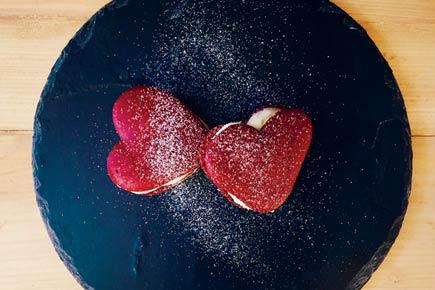
Did you know that the bright red in the classic tandoori chicken was traditionally derived from the spicy Kashmiri chillies? “When these chillies became prohibitively expensive, city restaurants started using regular chillies for the spice and added red colour. Unfortunately, this practice is prevalent till today,” rues acclaimed chef Atul Kochhar, who vowed to do away with artificial colouring, over 15 years ago, while working in London. “For a long time, my tandoori chicken was served white and when customers enquired, I simply said, ‘It’s because I don’t want to kill you’,” he recalls.
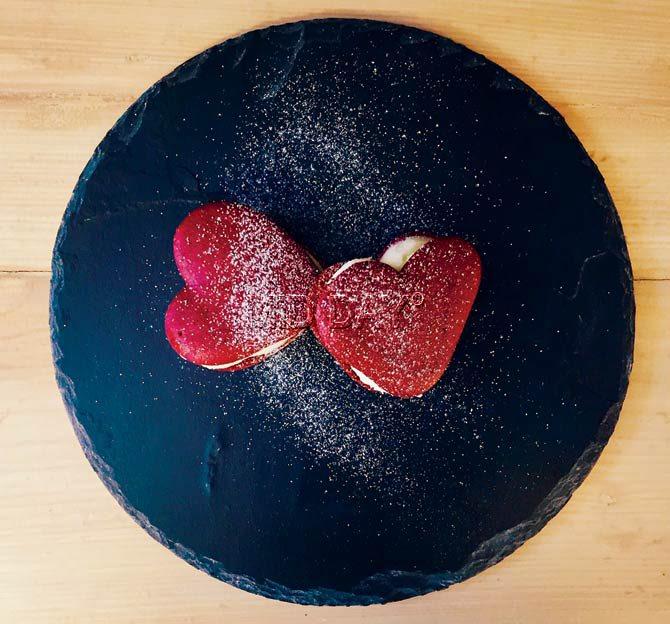
At Worli’s Ellipsis Bakery, beetroot extract helps add a blush red colour to Woopie Pie. Pics/Onkar Devlekar
ADVERTISEMENT
While Kochhar took the natural colour route a while back — something that’s also followed at his latest outing, NRI at BKC — Mars, Incorporated took the same pledge, earlier this month. In a press release issued on its portal, the global manufacturer stated that, ‘it will remove all artificial colours from its human food products as part of a commitment to meet evolving consumer preferences... Products across the range of the company’s chocolate, gum, confection, food and drink businesses will be affected by the change, which will take place incrementally over the next five years’.
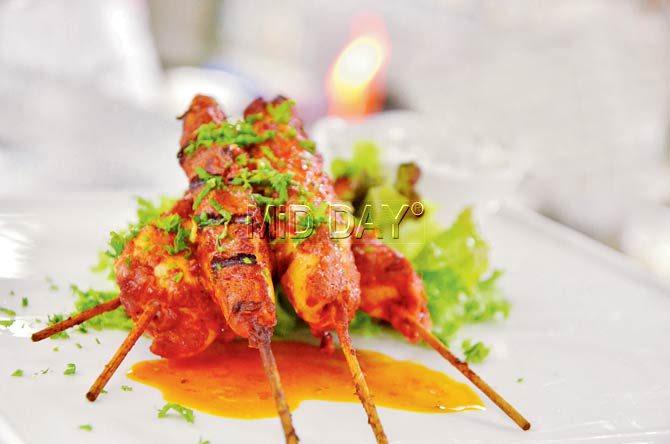
While harissa adds colour to Harissa Spiced Grilled Chicken, The Sassy Spoon recipe also includes colour from chilli oil, balsamic reduction and edible flowers, which give a bluish-purple tinge to clear spirits
Welcoming the move, Breach Candy’s go-to dessert chef Mehernosh Khajotia of Celebrations Fine Confections, who prefers pineapple, strawberry and pistachio toppings over his chocolate cake creations, says, “I salute Mars for coming out with a statement of this nature. Right now, India is crazy about colours in food. Today, customers are mainly interested in the appearance and shape of a cake. It ends up looking like a showpiece and the flavour goes out of the window.”
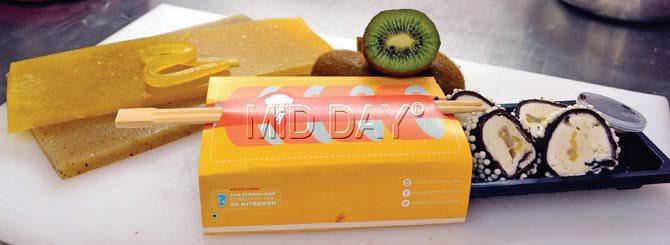
The Sushi Ice Cream at Papacream derives its colours from natural ingredients. For a step-by-step guide on how to roll it, log on to mid-day.com. Pic/Datta Kumbhar
Known for dishing out delectable Red Velvet and rainbow-coloured cakes, Kainaz Messman Harchandrai of Theobroma Patisserie counters, “Even where you do not expect to find added colourings (green peas, bread, fruit juice, pasta dishes, salmon), it is often used and is mostly undetected. As a participant within the food industry, we use good quality ingredients and that includes food colourings. A Ferrari or Superman’s Cape must necessarily be of a certain colour and for that, we have no option but to use food colouring. Natural colourings have improved considerably but still do not offer the same depth or the uniformity that we require. As a chef, I prioritise taste over everything else, but I cannot entirely ignore the first impression that the visual makes on the customer. We put most of our effort in getting the taste and texture right but we do add a sprinkling of colour to entice the customer into tasting it in the first place.”

Chef Mehernosh Khajotia uses burnt sugar to create a crystal shard-like effect on the cake
Siddharth Somaiya, chef and owner of Colaba’s The Bao Haus Co, adds, “So much emphasis has been put into pleasing Instagram that we are starting to lose the essence of good tasting food. The most common example is the red velvet cake. It’s so sad but even my friends had no idea that it’s just an ordinary sponge cake with red food colouring. In Asian cuisine, we’ve been using red food colouring for decades. Even the green kebabs have been using food colour for a long time. Char Siu (barbequed) Pork recipes call for this colour and dumplings have started becoming visual treats too.”
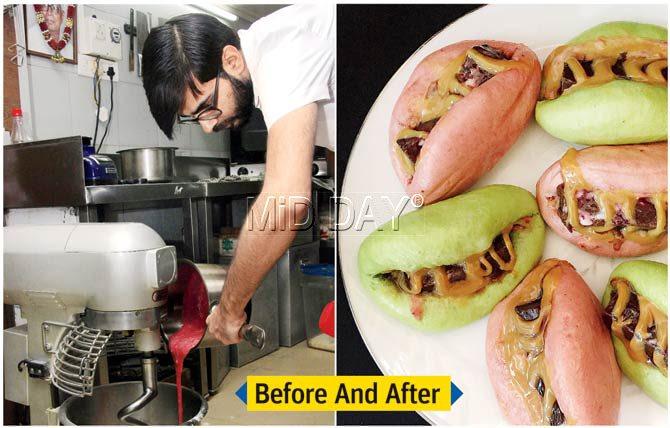
Chef Siddharth Somaiya mixes strawberry puree in the dough to make the Strawberry Bao at The Bao Haus Co. Colours are also derived from basil and carrot puree
A to Z of artificial colouring
The next time you dig into a kesar kulfi or a lemon tart, check if it’s actually saffron, lemon extract or Tartrazine, a popular synthetic yellow dye used in many recipes. Sudip Putatunda, food technologist at Koldplay Crémerie ice cream chain says, “Besides Tartrazine, Sunset Yellow and Ponceau Red are more popular, approved colours. The food laws in India (FSSAI) prescribe guidelines for the use of edible artificial colours and natural colours. These are considered to be safe. The true threat to public health is not from these colours, when used within prescribed limits, but from the use of unauthorised colours in the unorganised sector. For instance, the local gathia or jalebi could even be carcinogenic. However, it should be noted that some recent research, especially the famous Southampton University Study has linked even authorised artificial colours to hyperactivity in children apart from allergies, asthma, skin rashes etc.”
The cremerie, which is part of the Valentine Group, holding international patents for the extraction of natural colours, sticks to ingredients like annatto seed (releases the pigment norbixin) that gives a golden hue to their Motichoor ice cream and black carrot (releases the pigment anthocyanin) for their Very Berry variety.
Tanvi Chowdhri, CEO of Papacream says, “Synthetic food colours, also known as artificial food colours or food dyes, additives, food lake colour, etc, are processed and manufactured chemically. Usually, these are available as water-soluble or insoluble varieties as F,D&C (Food, Drug and Cosmetic) colours and D&C colours. Many dairy players use these colours, especially for their fruit-based ice creams to make the product resemble the fruit colour. Naturally, the fruit does not render such a bright colour because it gets diluted by milk and cream.” At their ice-cream parlour, the crowds are wooed with fresh fruit and cheesecake crumble, which adds contrast to the fruit puree-based mild pink strawberry ice cream, or the chocolate, kiwi, rice crispies and passion fruit infused Sushi variety.
Going natural
With farm-to-table, preservative-free and organic being the buzzwords in the city’s F&B industry today, many restaurant kitchens are now stocking up on red chilli paste, balsamic reduction, saffron, beetroot powder, turmeric, dried and powdered calendula flower petals and even red onions pickled in red wine vinegar to add colour to the plate. However, going natural isn’t a cakewalk. “These colours are not as vibrant and inviting as their artificial counterparts. Also, one needs to do many kitchen trials to perfect their use because when you are following a recipe, adding a drop of artificial colour will not change the flavour. However, when you substitute that with say, raspberry or beetroot puree, the nature of the recipe changes because these ingredients come with their own flavours,” shares Manu Chandra, chef partner, The Fatty Bao and Monkey Bar.
Khajotia provides an option, however, it comes at a price. “You do get air-dried fruit powder. These are extracts of fruits like strawberry, kiwi, pineapple and orange but then a 10 or 15 gm bottle would cost '10 to '15,000.”
The road ahead
Chef Irfan Pabaney of The Sassy Spoon opines, “Unfortunately, I don’t think artificial colours are ever going to go away unless there is a viable substitute. They add too much to our mundane lives to ignore. The key is to use them in moderation. After all, who wouldn’t want to see the smile on that little kid’s face when they dig into a slice of that rainbow cake?” Others, like Chowdhri, believe that modern techniques of gastronomy and a new chapter called ‘food art’ and ‘food theatre’ do make it possible to create the same visual impact with natural ingredients.
 Subscribe today by clicking the link and stay updated with the latest news!" Click here!
Subscribe today by clicking the link and stay updated with the latest news!" Click here!







